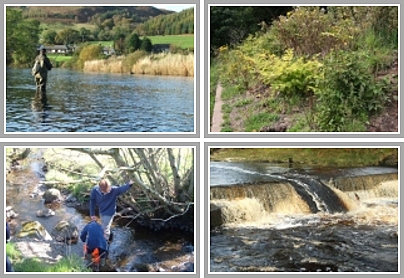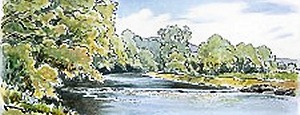
The coffer dam at the top of the site was overtopped by the spate. Fish were seem showing in the pool upstream.
I thought I’d give a quick update of the situation at Catrine now that there is a spate underway. There are salmon moving freely through the dam and ladder and we watched as several showed in the pool upstream. More were seen in the site itself. This is a relief that any fish that were held back by low flows over the last few weeks will now be able to reach the upper reaches. The greater concern is that more fish will be entering the system daily and if the water drops back and flows are reduce to allow the works to continue, then there may be even more fish stranded in Anderson’s pool in the next week or two. We will monitor this situation carefully and act accordingly.
I shot some video at the dam this morning and will post it this evening when I’ve had time to edit it.



Good to see a few fish making it through Stuart.
The ART are doing a great job at Catrine. I wonder what the situation would have been without you guys?
On a similar vein I see that the Stair Hydro scheme was granted a licence back in January. I assume that plans for work are not imminent?
Coupled with the Sorn application, the clock is being turned back on the River Ayr with redundant weirs being converted to hydro schemes. While I understand the demand for green energy, I can’t help but think some land/river owners are jumping on the bandwagon to obtain lucrative grants and subsidies at the expense of the river ecology. I’m not convinced SEPA are fit guardians of the environment when it comes to assessing these applications.
George,
thanks for your support. I’m pretty sure had ART not been involved in the consultations and negotiations, things at Catrine would certainly be heading towards a different outcome.
Regarding the other schemes that are in development, we are aware that the Sorn Hydro is a small development and will require the completion of a fish pass. (The current fish pass isn’t complete and therefore doesn’t constitute a fish pass in my book). In any case, it isn’t a good design as it’s at the upper limits of salmon’s swimming ability for a Larinier super active bottom baffle fish pass. It could be improved by extending it into the pool above the dam with an additional section or two and completing the installation of the lower baffles. It also requires the side walls to be increased in height to retain the flow that currently spills out. We gave the factor an estimate for these works using a local contractor a year or two ago but I think everything was delayed until the Estate investigated the hydro option. I understand they now have been instructed by SEPA to complete the fish pass within 1 year whether the scheme goes ahead or not.
Stair dam is a different kettle of fish altogether as it has already received approval. I don’t intend to comment further on this application at present as I’m not fully aware of how the plans have changed since Scottish Water Horizons withdrew from the proposal. We hope to be consulted shortly.
SEPA are the regulators and they should be skilled in determining the flow requirements for fish passage however we do provide expertise and comment as necessary, both independently and on behalf of Boards, when such schemes are in the consultation stages and we hope influence their final decisions when granting CAR licences or not. We wouldn’t object to such applications as a matter of course unless they are obviously flawed and detrimental to migratory species. Ultimately, we have to rely on SEPA to make a judgement and get it right. I do believe that the monitoring that accompanies these developments is crucial to determine whether there are impacts on fish populations and ecology over a period of time, and I expect where things are proven to need modified then SEPA would enforce this.